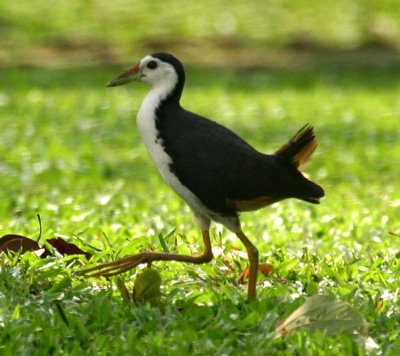Breeding Distraction: Lapwing and waterhen
"During the breeding season, eggs, chicks and fledlgings are vulnerable to many predators, including man. In many species, parent birds will go to all lengths to protect their brood. The female drongo will pluck off her long racket-like feathers to be less conspicuous when sitting in her nest; cisticolas will land several metres from the nest and run on the ground through thick grass to where the nest is located; many normally mild-mannered species will viciously chase away much larger would-be predators with great gusto.
"Some birds, like certain shorebirds will pretend to have a broken wing to distract the predator from the retreating chick. A couple of years ago, I observed a Red-wattled Lapwing (Vanellus indicus) run towards our vehicle, screaming loudly and feigning a broken wing as her young chick retreated quietly into the long grass adjacent to the dirt track that we were driving along.
 "On May 5th this year, I had the pleasure of witnessing two more such displays. First, at Serangoon, as Anthony Mercer, Shamla Subaraj and I were in our car driving slowly down a rough road, we stopped to observe a couple of White-breasted Waterhens (Amaurornis phoenicurus) (above and below) ahead of us. Immediately, one waterhen started running towards the car with wings held outstretched and above its head. While appearing in mock surrender, it also appeared to be charging our vehicle. It moved to the right of our vehicle and the reason for its display became apparent. We had inadvertently stopped right next to her small black chick, which was at the edge of a grass tussock. The adult carried a caterpillar and fed the chick upon reaching it, while shepherding it further into the vegetation. Later, we were to see a total of four small black chicks at the spot.
"On May 5th this year, I had the pleasure of witnessing two more such displays. First, at Serangoon, as Anthony Mercer, Shamla Subaraj and I were in our car driving slowly down a rough road, we stopped to observe a couple of White-breasted Waterhens (Amaurornis phoenicurus) (above and below) ahead of us. Immediately, one waterhen started running towards the car with wings held outstretched and above its head. While appearing in mock surrender, it also appeared to be charging our vehicle. It moved to the right of our vehicle and the reason for its display became apparent. We had inadvertently stopped right next to her small black chick, which was at the edge of a grass tussock. The adult carried a caterpillar and fed the chick upon reaching it, while shepherding it further into the vegetation. Later, we were to see a total of four small black chicks at the spot.  "Later that day, as the three of us drove around the reclamation area at Changi Central, we came across a strangely bold male Malaysian Plover (Charadrius peronii). This vulnerable resident is a sandy shore specialist and is highly localised in its local distribution. The male stood right in front of our car and seemed quite unafraid, providing excellent views. It literally tried to block us from turning our car into another track! Yet, this is a species that is normally fairly shy and would run quickly away from observers who moved too close. It did not dawn on me that it was trying to distract us, by making us focus on him, until the female materialised on the left of the vehicle. It too appeared quite unafraid and my conclusion was that they must have a nest nearby, though we did not look for it as we did not want to further disturb this threatened resident.
"Later that day, as the three of us drove around the reclamation area at Changi Central, we came across a strangely bold male Malaysian Plover (Charadrius peronii). This vulnerable resident is a sandy shore specialist and is highly localised in its local distribution. The male stood right in front of our car and seemed quite unafraid, providing excellent views. It literally tried to block us from turning our car into another track! Yet, this is a species that is normally fairly shy and would run quickly away from observers who moved too close. It did not dawn on me that it was trying to distract us, by making us focus on him, until the female materialised on the left of the vehicle. It too appeared quite unafraid and my conclusion was that they must have a nest nearby, though we did not look for it as we did not want to further disturb this threatened resident."The breeding season is upon us and lots of species are deeply involved in nesting. It would be most interesting to keep an eye out for other protective parents and their interesting methods of distraction."
Account by R. Subaraj and images by YC.



0 Comments:
Post a Comment
<< Home